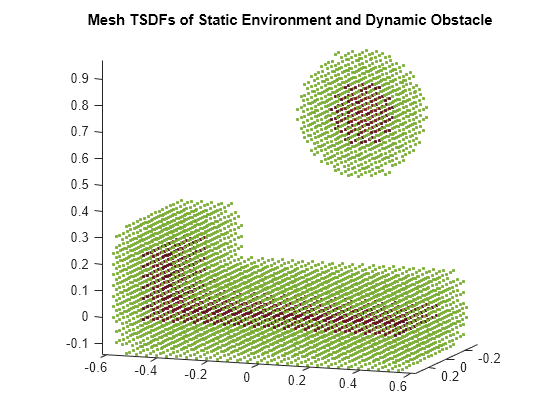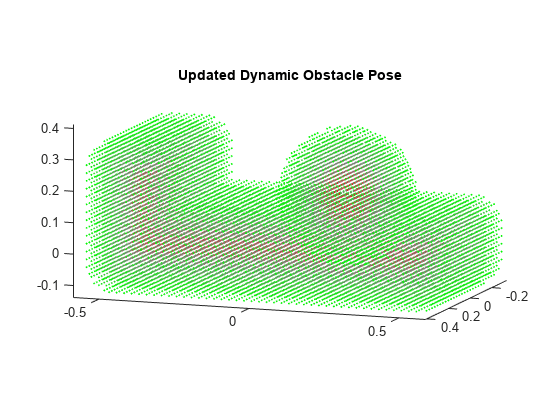addMesh
Description
isAdded = addMesh(mTSDF,meshStruct)
Examples
Create two collision boxes and one collision sphere. The collision boxes represent a static environment and the sphere represents a dynamic obstacle with a pose that could change at any time.
box1 = collisionBox(0.5,1,0.1);
box2 = collisionBox(0.5,0.1,0.2,Pose=trvec2tform([0 -0.45 0.15]));
sph = collisionSphere(0.125,Pose=trvec2tform([-0.1 0.25 0.75]));
showCollisionArray({box1,box2,sph});
title("Static Environment and Dynamic Obstacle")
v = [110 10];
view(v);
Create a mesh TSDF manager with a resolution of 25 cells per meter.
tsdfs = meshtsdf(Resolution=25);
To improve the efficiency of signed distance field computation, combine meshes that represent the static environment.
staticMeshes = geom2struct({box1,box2});
staticEnv = staticMeshes(1);
staticEnv.Pose = eye(4);
staticEnv.Vertices = [];
staticEnv.Faces = [];
for i = 1:numel(staticMeshes)
H = staticMeshes(i).Pose;
V = staticMeshes(i).Vertices*H(1:3,1:3)'+ H(1:3,end)';
nVert = size(staticEnv.Vertices,1);
staticEnv.Vertices = [staticEnv.Vertices; V];
staticEnv.Faces = [staticEnv.Faces; staticMeshes(i).Faces+nVert];
end
staticEnv.ID = 1;Add the static environment mesh to the TSDF manager.
addMesh(tsdfs,staticEnv);
Convert the sphere collision geometry into a structure for the mesh TSDF manager. Assign it an ID of 2 and add it to the mesh TSDF manager.
obstacleID = 2; dynamicObstacle = geom2struct(sph,obstacleID); addMesh(tsdfs,dynamicObstacle); show(tsdfs) view(v) axis equal title("Mesh TSDFs of Static Environment and Dynamic Obstacle")

Update the pose of the dynamic obstacle in the mesh TSDF manager by changing Pose property of the object handle of the obstacle. Then use the updatePose function to update the pose of the mesh in the TSDF manager.
dynamicObstacle.Pose = trvec2tform([0.2 0.25 0.2]); updatePose(tsdfs,dynamicObstacle)
ans = 1
show(tsdfs) view(v) axis equal title("Updated Dynamic Obstacle Pose")

Input Arguments
Truncated signed distance field for 3-D meshes, specified as a meshtsdf
object.
Example: meshtsdf(meshes,TruncationDistance=5) creates a TSDF for the
specified meshes with a truncation distance of 5
meters.
Geometry mesh, returned as a structure or an N-element structure array. N is the total number of collision objects.
Each structure contains these fields:
ID— ID of the geometry structure stored as a positive integer. By default, the ID of each structure corresponds to the index of the structure inmeshStruct. For example, ifmeshStructcontains five mesh structures, the first mesh structure at index 1 has anIDof1, and the last mesh structure at index 5 has anIDof5.Vertices— Vertices of the geometry, stored as an M-by-3 matrix. Each row represents a vertex in the form [x y z] with respect to the reference frame defined byPose. M is the number of vertices needed to represent the convex hull of the mesh.Faces— Faces of the geometry, stored as an M-by-3 matrix. Each row contains three indices corresponding to vertices inVerticesthat define a triangle faces of the geometry. M is the number of vertices inVertices.Pose— Pose of the geometry as a 4-by-4 homogeneous transformation matrix specifying a transformation from the world frame to the frame in which the vertices are defined.
Data Types: struct
Output Arguments
Indication of whether meshes were added or not, returned as logical
1 (true) if the mesh was successfully added or
0 (false) if the mesh you are adding a mesh with
an ID that already exists in mTSDF. If
meshStruct is an N-element of mesh structures,
then isAdded is an N-element vector of logical
scalars corresponding to each of the N mesh structures in
meshStruct.
Extended Capabilities
C/C++ Code Generation
Generate C and C++ code using MATLAB® Coder™.
Version History
Introduced in R2024a
See Also
MATLAB Command
You clicked a link that corresponds to this MATLAB command:
Run the command by entering it in the MATLAB Command Window. Web browsers do not support MATLAB commands.
选择网站
选择网站以获取翻译的可用内容,以及查看当地活动和优惠。根据您的位置,我们建议您选择:。
您也可以从以下列表中选择网站:
如何获得最佳网站性能
选择中国网站(中文或英文)以获得最佳网站性能。其他 MathWorks 国家/地区网站并未针对您所在位置的访问进行优化。
美洲
- América Latina (Español)
- Canada (English)
- United States (English)
欧洲
- Belgium (English)
- Denmark (English)
- Deutschland (Deutsch)
- España (Español)
- Finland (English)
- France (Français)
- Ireland (English)
- Italia (Italiano)
- Luxembourg (English)
- Netherlands (English)
- Norway (English)
- Österreich (Deutsch)
- Portugal (English)
- Sweden (English)
- Switzerland
- United Kingdom (English)